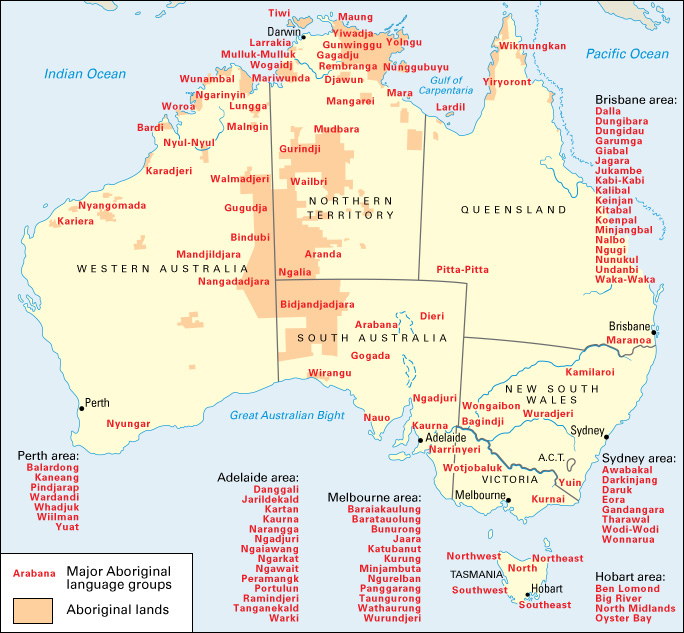Australian Aboriginal languages are the languages spoken by the first people of Australia, the Aboriginal peoples. Australia is a land with a great diversity (variety) of languages. In the 1780’s, at the time Europeans began settling in Australia, there were around 250 languages spoken by the continent’s Aboriginal peoples (see Australia, History of). Most linguists—scholars who study languages—divide these 250 languages among 25 or more language families. By contrast, modern Europe has nearly as many languages, but almost all of them fall into 3 main and several smaller language families.

One Australian language family is much larger than the others. The regions in which languages of the Pama-Nyungan family are spoken cover about 90 percent of Australia. Linguists generally place over 150 languages into this family. Australia’s other language families are mostly very small. Some of them consist of only one or two languages.
Australian languages tend to have very small numbers of speakers. Even the most widely spoken languages, such as Arrernte, have at most several thousand speakers each. When there are small numbers of speakers, a language can easily die out. Thus, all Australian languages are in danger of becoming extinct. However, even among some of the Australian languages that are the least spoken, children of the group associated with the language still learn it as their first language. The Gurr-goni language of Arnhem Land has only about 60 speakers, but it is the first language of the group’s children.
Grammar and syntax.
Grammar is the system by which a language functions. Syntax refers to the way that words in a language are strung together to make sentences. The grammar and syntax of Australian languages make them complex languages. Many Australian Aboriginal languages are as different from each other as English is from Finnish, Hindi, or Japanese.
Many Australian languages have a system of case. In such a system, the form of a noun changes depending on its role in the sentence. For example, in the Bardi language of Northwest Australia, a noun that describes being in a place contains the ending -goon, -oon, or -on. The word for in the sea, for example, is gaarragoon.
The word order in Australian languages varies depending on the language. Many Australian languages are free-word-order languages. This means that the order of words in a sentence does not give much grammatical information about who is acting and who or what is being acted upon. Word ordering in these languages is used to give the listener information about what the most important part of the sentence is.
For example, in Bardi, the word aambanim means man and iila means dog. Aambanim iila injalagal means the man sees the dog. We could also translate the English sentence into Bardi as iila aambanim injalagal, and it would mean the same thing. In the first sentence, it is the fact that the man is doing the seeing that is more important. In the second sentence, it is the fact that he saw a dog that is more important. In each case, it is the nim in aambanim that tells us that it is the man who is doing the seeing.
Many Australian languages also have what are sometimes called auxiliary or avoidance languages. These are special languages or parts of languages that are used only in certain circumstances. For example, many Central Australian and Queensland languages have a “mother-in-law” language. That is, when a man speaks to his wife’s mother or certain other relatives, he does not use the usual words in the language. Instead, he uses a language of respect that employs different words. There are also special languages that are used during Aboriginal initiation rites and languages used in writing song poetry, a traditional form of Aboriginal oral literature.
Development.
Many linguists believe that all Australian languages developed from a single ancestor language. Although there was a land bridge (a neck of land connecting two land masses) between Australia and Papua New Guinea until about 7,000 to 9,000 years ago, there are no Australian languages spoken outside of Australia. That ancestor language would have been spoken so long ago that scholars know very little about it.
Europeans first settled permanently in Australia in 1788. The early days of European settlement were hard on Aboriginal peoples. There were numerous massacres, government policies of forced child removal, and epidemics (outbreaks of disease). By 1920, the Aboriginal population was only about 10 to 20 percent the size it had been 150 years before. As a result, many Australian Aboriginal languages fell out of use or all their speakers died.
European settlement, however, affected different groups at different times. In the desert and the more remote areas of the country, Aboriginal people were able to continue traditional ways of life longer than in the southeast. In modern times, the areas where there are still sizable numbers of Aboriginal language speakers are all in the central and northern parts of the country—the Northern Territory, far northern Queensland, and the areas outside the major urban centers of Western Australia and South Australia. Of the original languages, probably no more than 20 are still being taught to children as a first language. Most Aboriginal people in Australia today speak English or Kriol, a mix of English and several Aboriginal languages.
Although many Australian languages are in danger of disappearing, some are still healthy. Some languages that had ceased to be used in the 1800’s are now being spoken again. The Kaurna language of the Adelaide Plains, for example, is known mostly from work by German missionaries in the 1820’s to 1840’s. Work by the Australian linguist Rob Amery and Kaurna community members has led to a revitalization of the language. Amery and others are coining new Kaurna words for technology terms and for other concepts that were not recorded in earlier times. Kaurna is now taught in some Adelaide schools and used in both public and private spheres.
